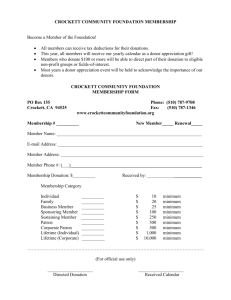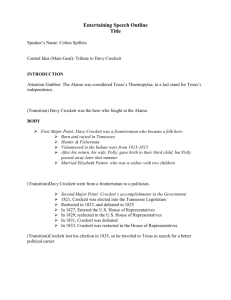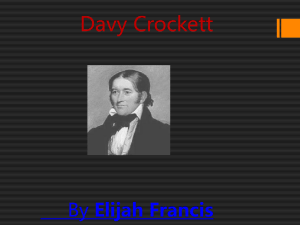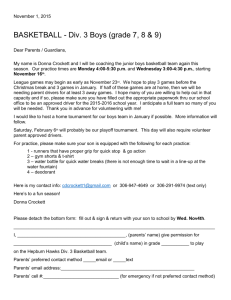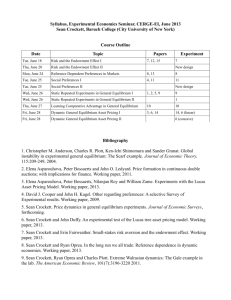David Crockett
advertisement
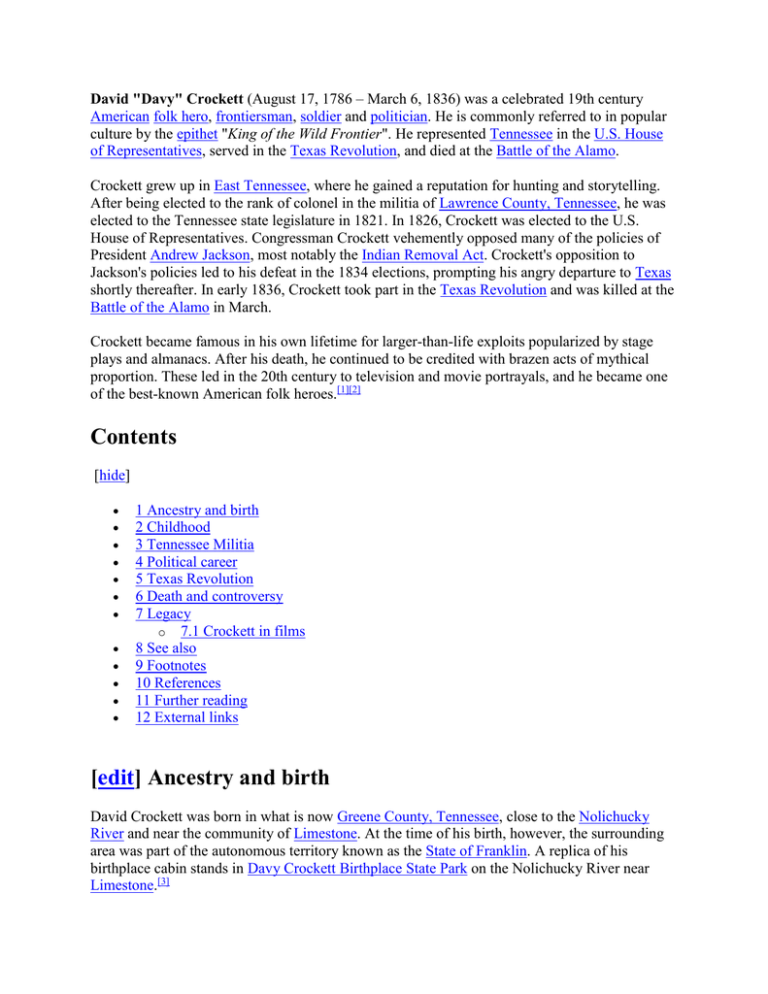
David "Davy" Crockett (August 17, 1786 – March 6, 1836) was a celebrated 19th century American folk hero, frontiersman, soldier and politician. He is commonly referred to in popular culture by the epithet "King of the Wild Frontier". He represented Tennessee in the U.S. House of Representatives, served in the Texas Revolution, and died at the Battle of the Alamo. Crockett grew up in East Tennessee, where he gained a reputation for hunting and storytelling. After being elected to the rank of colonel in the militia of Lawrence County, Tennessee, he was elected to the Tennessee state legislature in 1821. In 1826, Crockett was elected to the U.S. House of Representatives. Congressman Crockett vehemently opposed many of the policies of President Andrew Jackson, most notably the Indian Removal Act. Crockett's opposition to Jackson's policies led to his defeat in the 1834 elections, prompting his angry departure to Texas shortly thereafter. In early 1836, Crockett took part in the Texas Revolution and was killed at the Battle of the Alamo in March. Crockett became famous in his own lifetime for larger-than-life exploits popularized by stage plays and almanacs. After his death, he continued to be credited with brazen acts of mythical proportion. These led in the 20th century to television and movie portrayals, and he became one of the best-known American folk heroes.[1][2] Contents [hide] 1 Ancestry and birth 2 Childhood 3 Tennessee Militia 4 Political career 5 Texas Revolution 6 Death and controversy 7 Legacy o 7.1 Crockett in films 8 See also 9 Footnotes 10 References 11 Further reading 12 External links [edit] Ancestry and birth David Crockett was born in what is now Greene County, Tennessee, close to the Nolichucky River and near the community of Limestone. At the time of his birth, however, the surrounding area was part of the autonomous territory known as the State of Franklin. A replica of his birthplace cabin stands in Davy Crockett Birthplace State Park on the Nolichucky River near Limestone.[3] Crockett was of primarily Irish, English, Scottish, and French Huguenot ancestry,[4] the family name being derived from Monsieur de la Croquetagne, a captain in the Royal Guard of French King Louis XIV.[5] The family converted to Protestantism and, as Huguenots, fled persecution in 17th century France to settle in Ireland. Family tradition says that Crockett's father was born on the voyage to America from Ireland, though in fact Crockett's great-grandfather, William David Crockett, was registered as having been born in New Rochelle, New York in 1709. Commemorative stone David Crockett was the fifth of nine children of John Crockett and Rebecca Hawkins. He was named after his paternal grandfather, who was killed in 1777 at his home near today's Rogersville, Tennessee, by Indians led by Dragging Canoe.[6] Crockett's father was one of the Overmountain Men who fought in the Battle of Kings Mountain during the American Revolutionary War. The Crocketts moved to Morristown, Tennessee, in the 1790s and built a tavern there. A museum stands on the site and is housed in a reconstruction of the tavern.[7] [edit] Childhood Replica cabin at Crockett birthsite In his autobiography, Crockett told that his early years were filled with adventure, hardship, and travel. When he was eight years old, he told his father he wanted to hunt with a rifle. Crockett promised to make every shot count, and began hunting with his older brothers. After being sent to school when he was 13, he dropped out to run away from home to avoid a beating at the hands of his father. Crockett said he had "whupped the tar" out of a school bully who had embarrassed him on his fourth day in school. Crockett decided not to return to school for the next few days, fearing the bully would return with some friends backing him up, as well as the teacher's punishments. The teacher eventually wrote to Crockett's father to ask why his son did not attend class. Crockett told his father the truth. Angry that family trade goods exchanged for his son's education had gone to waste, he refused to listen. Crockett ran away from home and spent three years roaming from town to town. He claimed he visited most of the towns and villages in Tennessee and learned his skills as a outdoors-man, hunter and trapper.[citation needed] Near his 16th birthday, David Crockett returned home. Before Crockett had left, his father had opened a tavern on the road between Knoxville, Tennessee and Abingdon, Virginia. Crockett stopped in for a meal unannounced. The first to finally recognize him, his older sister, Betsy, cried, "Here is my lost brother! Look! He is home!" The family was delighted and he was welcomed back. His father was in debt, so he hired Davy out to Abraham Wilson to settle a debt of $36. Later, Crockett generously worked off a $40 debt to John Kennedy. In return, John Crockett told his son he was free to leave. Davy went to work again for Kennedy, this time working for himself.[citation needed] Contract of marriage for October 21, 1805 Shortly afterwards, Crockett became engaged to Margaret Elder and, although the marriage never took place, the contract of marriage (dated October 21, 1805) has been preserved by the Dandridge, Tennessee, courthouse. It is well documented that Crockett's bride-to-be changed her mind and married someone else. Heartbroken at age 19, Crockett decided he was "only born for hardships, misery, and disappointment".[8][9] On August 16, 1806, one day before his 20th birthday, Crockett married Mary (Polly) Finley in Jefferson County, Tennessee.[10] They had two sons: John Wesley Crockett was born July 10, 1807, followed by William Finley Crockett (born 1809). They also had a daughter, Margaret Finley (Polly) Crockett in 1812. As wild game ran scarce, the Crocketts then moved to Franklin County, Tennessee in 1813. He named the new settlement on Beans Creek "Kentuck." [11] After his wife Polly's death, Crockett married a widow named Elizabeth Patton in 1815; they had three children: Robert, Rebecca and Matilda. [edit] Tennessee Militia US Postage, issue of 1967 On September 24, 1813, Crockett joined the Second Regiment of Tennessee Volunteer Mounted Riflemen for an initial term of 60 days and served under Colonel John Coffee in the Creek War, marching south into present day Alabama and taking an active part in the fighting. Made a scout because of his abilities as a hunter, trapper, and woodsman, Crockett is known to supposedly have supported the starving troops during the time of the Creek War with the game he hunted. He was eventually discharged from service on March 27, 1814. Crockett was elected Lieutenant Colonel of the Fifty-seventh Regiment of Tennessee Militia on March 27, 1818.[12] [edit] Political career On September 17, 1821, Crockett was elected to the Committee of Propositions and Grievances. He lost his first run for Congress in 1824, but ran again in the next election. In 1826 he was elected to the United States House of Representatives as a Jacksonian. As a Congressman, Crockett supported the rights of squatters, who were barred from buying land in the West without already owning property. He also joined the Anti-Jacksonians in opposing President Andrew Jackson's Indian Removal Act, and his opposition to Jackson caused his defeat when he ran for re-election in 1830; however, he won when he ran again in 1832. As he explained, "I bark at no man's bid. I will never come and go, and fetch and carry, at the whistle of the great man in the White House no matter who he is."[13] Fess Parker as Crockett addresses the city of Philadelphia in the Walt Disney television miniseries Under the date of November 26, 1833, John Quincy Adams records in his diary an encounter with Crockett, whom he quotes as saying that he (Crockett) "had taken for lodgings two rooms on the first floor of a boarding-house, where he expected to pass the winter and to have for a fellow-lodger Major Jack Downing, the only person in whom he had any confidence for information of what the Government was doing."[14] In an 1884 book written by dime novelist[15] and non-fiction author[16] Edward S. Ellis, Crockett is recorded as giving a speech (the "Not Yours to Give" speech) critical of his Congressional colleagues who were willing to spend taxpayer dollars to help a widow of a US Navy man who had lived beyond his naval service, but would not contribute their own salary for a week to the cause.[17] Ellis describes how the once popular proposal died in the Congress largely as a result of the speech. It was said that a man from Crockett's district, Horatio Bunce, converted Crockett to such a course of action by explaining that the Constitution did not allow Congress to give charity.[17] The authenticity of this speech is questioned, however, since the Register of Debates and the Congressional Globe do not contain transcripts of speeches made on the House floor. Crockett is on record opposing a similar bill and offering personal support to the family of a General Brown in April 1828,[18] but Crockett considered applications for relief on a case by case basis and sometimes voted in favor of the applicant.[19] An article by Crockett biographer James R. Boylston debunking the "Not Yours to Give" speech was published in the November 2004 issue of The Crockett Chronicle.[20] In 1834, his autobiography titled A Narrative of the Life of David Crockett. Written by Himself was published.[21] Crockett went east to promote the book and was narrowly defeated for reelection. He said, "I told the people of my district that I would serve them as faithfully as I had done; but if not ... you may all go to hell, and I will go to Texas." Following his defeat, he did just that. [edit] Texas Revolution Portrait of Davy Crockett by John Gadsby Chapman By December, 1834, Crockett was writing to friends about moving to Texas if Van Buren were elected President. The next year he discussed with his friend Benjamin McCulloch raising a company of volunteers to take to Texas in the expectation that a revolution was imminent.[22] After the election results became known in August, his departure to Texas was delayed by a court appearance in the last week of October as co-executor of his deceased father-in-law’s estate, and he finally left his home near Rutherford in West Tennessee on Nov. 1, 1835, with three other men to explore Texas.[23] His youngest child, Matilda, later wrote that she distinctly remembered the last time she saw her father: "He was dressed in his hunting suit, wearing a coonskin cap, and carried a fine rifle presented to him by friends in Philadelphia . . . He seemed very confident the morning he went away that he would soon have us all to join him in Texas."[24] From his home he traveled to Jackson, arriving there with 30 well-armed men, where he gave a speech from the steps of the Madison County courthouse, and then rode southwest to Bolivar, where he spent the night at residence of Dr. Calvin Jones, once again drawing crowds who sent him off the next morning.[25] He arrived in Memphis in the second week of November with a much-diminished company, and ferried over the Mississippi River the next day and continued his journey on horseback through Arkansas.[26] On Nov. 12, 1835, Crockett and his entourage arrived in Little Rock, Arkansas. The local newspapers reported that hundreds of people swarmed into town to get a look at Crockett, and a group of leading citizens put on a dinner in his honor that night at the Jeffries Hotel. Crockett spoke “mainly to the subject of Texan independence,” as well as Washington politics.[27] He arrived in Nacogdoches, Texas, in early January 1836. On January 14, 1836, Crockett and 65 other men signed an oath before Judge John Forbes to the Provisional Government of Texas for six months: "I have taken the oath of government and have enrolled my name as a volunteer and will set out for the Rio Grande in a few days with the volunteers from the United States." Each man was promised about 4,600 acres (19 km2) of land as payment. He also sold two rifles to Colonel O'Neal for $60. (After his death there was a claim for his heirs for $57.50. In 1854 his widow received a payment certificate for $24.00 from Texas.) On February 6, Crockett and about five other men rode into San Antonio de Bexar and camped just outside the town. They were later greeted by James Bowie and Antonio Menchaca, and taken to the home of Don Erasmo Seguin. Crockett arrived at the Alamo on February 8.[28] To the surprise of the men garrisoned in the Alamo, on February 23, a Mexican army, led by General Antonio Lopez de Santa Anna, arrived. The Mexican soldiers immediately initiated a siege.[29][30] Santa Anna ordered his artillery to keep up a near-constant bombardment. The guns were moved closer to the Alamo each day, increasing their effectiveness. On February 25, 200–300 Mexican soldiers crossed the San Antonio River and took cover in abandoned shacks approximately 90 yards (82 m) to 100 yards (91 m) from the Alamo walls.[31][32] The soldiers intended to use the huts as cover to establish another artillery position, although many Texians assumed that they actually were launching an assault on the fort.[33] Several men volunteered to burn the huts.[34] To provide cover, the Alamo cannons fired grapeshot at the Mexican soldiers, and Crockett and his men fired rifles, while other defenders reloaded extra weapons for them to use in maintaining a steady fire. Within two hours, the battle was over,[33] and the Mexican soldiers retreated.[35] Inside the Alamo, the stores of powder and shot were limited. On February 26, Travis ordered the artillery to stop returning fire so as to conserve precious ammunition. Crockett and his men were encouraged to keep shooting, as they were unusually effective.[36] As the siege progressed, Alamo commander William Barret Travis sent many messages asking for reinforcements. Several messengers were sent to James Fannin, who commanded the only other official group of Texian soldiers. Fannin and several hundred Texians occupied Presidio La Bahia at Goliad. Although Fannin ultimately decided it was too risky to attempt to reinforce the Alamo, historian Thomas Ricks Lindley concludes that up to 50 of Fannin's men left his command to go to Bexar.[37] These men would have reached Cibolo Creek, 35 miles (56 km) from the Alamo, on the afternoon of March 3. There they joined another group of men who also planned to join the garrison.[38] That same night, outside the Alamo, there was a skirmish between Mexican and Texian troops.[39] Several historians, including Walter Lord, speculated that the Texians were creating a diversion to allow their last courier, John Smith, to evade Mexican pickets.[40] However, in 1876, Alamo survivor Susannah Dickinson said that Travis sent three men out shortly after dark on March 3, probably a response to the arrival of Mexican reinforcements. The three men, who included Crockett, were sent to find Fannin.[41] Lindley stated that just before midnight, Crockett and one of the other men found the force of Texians waiting along Cibolo Creek, who had advanced to within 20 miles (32 km) of the Alamo. Just before daylight on March 4, part of the Texian force managed to break through the Mexican lines and enter the Alamo. A second group was driven across the prairie by Mexican cavalry.[42] The Fall of the Alamo by Robert Jenkins Onderdonk depicts Davy Crockett swinging his rifle at Mexican troops who have breached the south gate of the mission. The siege ended on March 6, when the Mexican army attacked just before dawn while the defenders were sleeping. The daily bombardment by artillery had been suspended, perhaps a ploy to encourage the natural human reaction to a cessation of constant strain. But the garrison awakened and the final fight began. Most of the noncombatants gathered in the church sacristy for safety. According to Dickinson, before running to his post, Crockett paused briefly in the chapel to say a prayer.[43] When the Mexican soldiers breached the north outer walls of the Alamo complex, most of the Texians fell back to the barracks and the chapel, as previously planned.[44] Crockett and his men were too far from the barracks to take shelter.[45] and were the last remaining group in the mission to be in the open. The men defended the low wall in front of the church, using their rifles as clubs and relying on knives, as the action was too furious to allow reloading. After a volley and a charge with bayonets, Mexican soldiers pushed the few remaining defenders back toward the church.[46] The Battle of the Alamo lasted almost 90 minutes.[47] Once all of the defenders had been killed, Santa Anna ordered his men to take the bodies to a nearby stand of trees where they were stacked together and wood piled on top.[48] That evening, a fire was lit and the bodies of the defenders were burned to ashes.[49] A coffin in the San Fernando Cathedral purports to hold the ashes of the Alamo defenders. However, historians believe it more probable that the ashes were buried near the Alamo. The ashes were left undisturbed until February 1837, when Juan Seguin and his cavalry returned to Bexar to examine the remains. A local carpenter created a simple coffin, and ashes from the funeral pyres were placed inside. The names of Travis, Crockett, and Bowie were inscribed on the lid.[50] The coffin is thought to have been buried in a peach tree grove, but the spot was not marked and can no longer be identified.[51] [edit] Death and controversy All that is certain about the fate of David Crockett is that he died at the Alamo on March 6. According to many accounts of the battle, between five and seven Texians surrendered during the battle, possibly to General Castrillon.[52][53] Incensed that his orders had been ignored, Santa Anna demanded the immediate execution of the survivors. Although Castrillon and several other officers refused to do so, staff officers who had not participated in the fighting drew their swords and killed the unarmed Texians.[54] Weeks after the battle, stories began to circulate that Crockett was among those who surrendered and were executed.[53] However, Ben, a former American slave who acted as cook for one of Santa Anna's officers, maintained that Crockett's body was found in the barracks surrounded by "no less than sixteen Mexican corpses", with Crockett's knife buried in one of them.[55] Historians disagree on which story is accurate. According to Petite, "every account of the Crockett surrender-execution story comes from an avowed antagonist (either on political or military grounds) of Santa Anna's. It is believed that many stories, such as the surrender and execution of Crockett, were created and spread in order to discredit Santa Anna and add to his role as villain."[56] In 1955 Jesús Sánchez Garza self-published a book called La Rebelión de Texas—Manuscrito Inédito de 1836 por un Ofical de Santa Anna purporting to be memoirs of José Enrique de la Peña, a Mexican officer present at the Battle of the Alamo. In 1975 the Texas A&M University Press published an English translation of the book, called With Santa Anna in Texas: A Personal Narrative of the Revolution. The English publication caused a scandal within the United States as it asserted that Crockett did not die in battle.[57] Historians disagree on whether any or all of the book has been falsified.[57][58] Because the original book was self-published, no editor or publisher ever vetted its authenticity.[59] Garza never explained how he gained custody of the documents or where they were stored after de la Peña's death.[60] Some historians, including Bill Groneman, found it suspicious that Garza's compilation was published in 1955, at the height of interest in Crockett and the Alamo caused by Walt Disney's television miniseries about Crockett's life, Davy Crockett. Groneman also points out that the journals are made up of several different types of paper from several different paper manufacturers, all cut down to fit.[60] Historian Joseph Musso also questions the validity, likewise basing his suspicions on the timing of the diaries' release. In de la Peña's narrative, he adds a footnote which may align both versions. He states that "All of the enemy perished, there remaining alive only an elderly lady and a Negro slave, whom the soldiers spared out of mercy and because we had established that only force had kept them in danger." (Perry 1975) This implies that the summary execution of the survivors may have occurred prior to the releasing of Dickinson and Joe, so that they observed Crockett as dead, lending credence to their testimony. De la Peña describes the disposal of the dead and wounded as an ongoing process that took some time. First, no other accounts of Crockett surviving the Alamo have surfaced besides de la Peña's diary. No documentation in the archives of the Mexican government, nor any of the personal records of others present at the Battle of the Alamo, give any hint of survivors amongst the defenders, much less any claiming Crockett as a survivor. Secondly, there is some speculation that de la Peña's account may have been a deliberate fabrication, with the intention of presenting Santa Anna in a far more diabolical light than American (and especially Texan) historians have given him since the fall of the Alamo. The written account by de la Peña, even if a legitimate writing, has also been questioned in that many doubt his abilities to identify any of the Alamo defenders by name. It is a popular belief by many historians that de la Peña may have witnessed or been told about executions of some Alamo survivors, but in fact neither he nor his comrades would have known who these men were. Part of the reason that de la Peña's memoirs are questioned comes from his detailed account of Col. William Travis' death in "With Santa Anna in Texas". In that account, he describes with detail how Travis was heroic in his final moments, turning straight into the Mexican soldiers and facing his death with honor. The problem with this is: how would de la Peña have been able to distinguish Travis from any of the other defenders of the Alamo? The freed former slave to Travis, Joe, claimed Travis died early on in the battle, on the north wall. In addition to this, the Mexican Army had not breached the walls of the Alamo when Travis was killed, therefore they would have been seeing him from an area below the walls, while being fired down upon by the defenders. To add to this, Travis was killed before daybreak, meaning it was still dark. Therefore, it is believed that de la Peña either created the scenario of Travis' death, or he saw another of the defenders after breaching the walls, and took him to be Travis.[61] [edit] Legacy One tale tells how Crockett greeted a crowd on his way to Congress. He bragged, "I'm that same David Crockett, fresh from the backwoods, half-horse, half-alligator, a little touched with the snapping turtle; can wade the Mississippi, leap the Ohio, ride upon a streak of lightning, and slip without a scratch down a honey locust [tree]." David Crockett clipper ship card Davy Crockett’s Almanac, of Wild Sports in the West, Life in the Backwoods, & Sketches of Texas, a jest book, printed the text of a speech Crockett supposedly made to Congress. While there is no evidence whatever that the speech is authentic, it suggests the image of Crockett promoted by the "Crockett Almanacs," published annually for years after his death "Mr. Speaker. "Who-Who-Whoop — Bow-Wow-Wow-Yough. I say, Mr. Speaker; I ve had a speech in soak this six months, and it has swelled me like a drowned horse; if I don’t deliver it I shall burst and smash the windows. The gentleman from Massachusetts [Mr. Everett] talks of summing up the merits of the question, but I’ll sum up my own. In one word I’m a screamer, and have got the roughest racking horse, the prettiest sister, the surest rifle and the ugliest dog in the district. I’m a leetle the savagest crittur you ever did see. My father can whip any man in Kentucky, and I can lick my father. I can outspeak any man on this floor, and give him two hours start. I can run faster, dive deeper, stay longer under, and come out drier, than any chap this side the big Swamp. I can outlook a panther and outstare a flash of lightning, tote a steamboat on my back and play at rough and tumble with a lion, and an occasional kick from a zebra. "To sum up all in one word I’m a horse. Goliah was a pretty hard colt but I could choke him. I can take the rag off-frighten the old folks-astonish the natives-and beat the Dutch all to smashmake nothing of sleeping under a blanket of snow and don’t mind being frozen more than a rotten apple. "Congress allows lemonade to the members and has it charged under the head of stationery-I move also that whiskey be allowed under the item of fuel. For bitters I can suck away at a noggin of aquafortis, sweetened with brimstone, stirred with a lightning rod, and skimmed with a hurricane. I’ve soaked my head and shoulders in Salt River, so much that I’m always corned. I can walk like an ox, run like a fox, swim like an eel, yell like an Indian, fight like a devil, spout like an earthquake, make love like a mad bull, and swallow a Mexican whole without choking if you butter his head and pin his ears back." One of Crockett's sayings, which were published in almanacs between 1835 and 1856 (along with those of Daniel Boone and Kit Carson), was: “ Always be sure you are right, then go ahead ” In 1838, Robert Patton Crockett went to Texas to administer his father's land claim. In 1854, Elizabeth Crockett finally came to Texas to live, dying in 1860. Crockett's son John Wesley Crockett was a U.S. Congressman from Tennessee, serving two terms between 1837 and 1841. A section of U.S. Route 64 between Winchester, Tennessee and Lawrenceburg, Tennessee is signed as David Crockett Memorial Highway. By the late 19th century, Crockett was largely forgotten. His legend was reborn in a 1950s TV show by Walt Disney, which also introduced his legendary coonskin cap. In 1948, Disney told columnist Hedda Hopper that it was "time to get acquainted, or renew acquaintance with, the robust, cheerful, energetic and representative folk heroes".[62] As part of a deal that allowed him to build a theme park, Disneyland, Disney would produce weekly one-hour television programs for ABC.[63] Disney wished to highlight historical figures and his company developed three episodes on Crockett—Davy Crockett, Indian Fighter, Davy Crockett Goes to Congress, and Davy Crockett at the Alamo— starring Fess Parker as Crockett. According to historians Randy Roberts and James Olson, "by the end of the three shows, Fess Parker would be very well known, the power of television would be fully recognized, and Davy Crockett would be the most famous frontiersman in American history."[64] The shows sparked heated debate, with many questioning whether Crockett was really deserving of the amount of attention he was now receiving. Letter writers also questioned the series' historical accuracy.[65] Nevertheless, the shows proved very popular. They were combined into a feature-length movie in the summer of 1955, and Parker and his co-star Buddy Ebsen toured the United States, Europe, and Japan. By the end of 1955, Americans had purchased over $300 million worth of Davy Crockett merchandise ($2 billion by 2001).[66] The television series also introduced a new song, "The Ballad of Davy Crockett". Four different versions of the song hit the Billboard Best Sellers pop chart in 1955. The versions by Bill Hayes, TV series star Fess Parker, The Wellingtons and Tennessee Ernie Ford charted in the Top 10 simultaneously, with Hayes' version hitting #1. The shows were repeated on NBC in the 1960s after Disney had moved his program to that network. The 1960 repeats marked the first time that the programs had actually been shown in color on TV. Davy Crockett made a return with Disney in two further adventures: Davy Crockett's Keelboat Race and Davy Crockett and the River Pirates. In these two episodes Crockett faced off against Mike Fink, another early American legend. A three-episode 1988–89 revival was made entitled The New Adventures of Davy Crockett, in which Tim Dunigan took over Fess Parker's famous role. Johnny Cash played an older Davy in a few scenes set before he went to Texas. The fad eventually waned, but Crockett was often a prominent role in movies about the Alamo. In the 1960 film The Alamo, John Wayne portrayed Crockett. More recently was the John Lee Hancock version of The Alamo (2004). This Crockett, played by Billy Bob Thornton, is portrayed as a man trying to downplay his legend, but in the end unable to escape it. This is epitomized in a scene where Crockett, speaking to Bowie says, "If it was just me, simple old David from Tennessee, I might drop over that wall some night, take my chances. But that Davy Crockett feller...they're all watchin' him." A seventh-season episode of the Discovery Channel series MythBusters explored a story of Crockett's backwoods exploits: that he could stick an axe into a tree trunk, fire his long rifle from 40 yards away, and hit the edge so precisely that the bullet would split in two. After some practice, Tory Belleci was able to duplicate the feat from 20 yards with the gun resting on sandbags and declared the myth "Confirmed," reasoning that Crockett could have consistently made the 40-yard shot with enough experience. In 1821, Davy Crockett was elected to the Tennessee legislature, with speeches filled with yarns and homespun metaphors. In the legislature an opposing speaker referred to Crockett’s background in western Tennessee, where he hunted bears and raccoons. This image of the rough backwoods legislator caught the popular imagination during Crockett's lifetime and continued to do so after his death. David "Davy" Crockett (1786-1836) Davy Crockett was perhaps best known in Tennessee as a noted hunter and for his unique style of backwoods oratory. In Texas, however, he will always be remembered as a heroic participant in the Battle of the Alamo. Crockett was born 17 August 1786 in what is now northeastern Tennessee. It was not until he was eighteen before he learned to read and write. About that time, he married and started a family of several children. Perhaps by default, he first became involved in politics as magistrate of his local community. By 1821, he was elected to the State Legislature, and was reelected to that position in 1823. From 1827 through 1833, Crockett served in the Congress of the United States. However, in his run for a fourth term in Congress, he was defeated by a narrow margin. Disgusted by that time with politics, Crockett bid farewell to Tennessee and headed for Texas in the fall of 1835. There he was well received and seemed to enjoy his new environment, for on 9 January 1836 he wrote a daughter back in Tennessee: "I would rather be in my present situation than to be elected to a seat in Congress for life." Less than one month later, however, Crockett and a few of his fellow Tennesseans were among the 189 defenders that sacrificed their lives at The Battle of the Alamo in the interest on Texas independence. Born: August 17, 1786 Hawkings County, Tennessee Died: March 6, 1836 San Antonio, Texas American frontiersman and politician Read more: Davy Crockett Biography - life, family, children, death, wife, son, book, old, information, born http://www.notablebiographies.com/Co-Da/CrockettDavy.html#ixzz1qzR2EU3D
